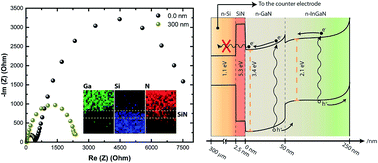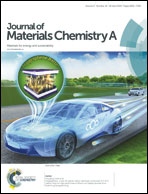Water splitting to hydrogen over epitaxially grown InGaN nanowires on a metallic titanium/silicon template: reduced interfacial transfer resistance and improved stability to hydrogen
Abstract
Water splitting using InGaN-based photocatalysts may make a great contribution to future renewable energy production systems. Among the most important parameters that need to be optimized are those related to substrate lattice-matching compatibility. Here, we directly grow InGaN nanowires (NWs) on a metallic Ti/Si template, for improving the water splitting performance compared to a bare Si substrate. The open circuit potential of the epitaxially grown InGaN NWs on metallic Ti was almost two times higher than when directly grown on the Si substrate. The interfacial transfer resistance was also reduced significantly after introducing the metallic Ti interlayer. An applied-bias-photon-to-current conversion efficiency of 2.2% and almost unity faradaic efficiency for hydrogen generation were achieved using this approach. The InGaN NWs grown on Ti showed improved stability for hydrogen generation under continuous operation conditions, when compared to those grown on Si, emphasizing the role of the semiconductor-on-metal approach in enhancing the overall efficiency of water splitting devices.



 Please wait while we load your content...
Please wait while we load your content...